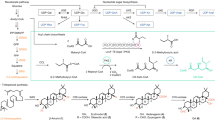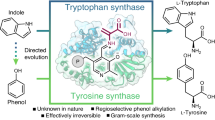Abstract
ONLY two compounds, 11-cis-retinal I and 11-cis-3-dehydroretinal II, have been found to act as chromophores in naturally occurring visual pigments1. These compounds contain one and two double bonds respectively in the cyclic portion of the structure. The analogous compound, 5,6-dihydroretinal III which is similar in all other respects to retinal except that the ring is saturated, has not been isolated from the retina. Recombination experiments, in which visual pigments are formed from the corresponding visual protein and one of the naturally occurring retinals, show further selectivity on the part of the protein2. This selectivity is manifested by the protein's ability to discriminate between the geometrical isomers of naturally occurring retinals. Consequently, the 11-cis and 9-cis isomers combine with visual proteins to produce visual pigments, whereas the all-trans and 13-cis isomers do not. Only the 11-cis isomer combines with a visual protein to form a pigment identical to those which occur naturally. In this article, we report the formation of a new synthetic pigment from 5,6-dihydroretinal III and cattle opsin; we also describe some of its spectral properties and photochemical behaviour. Apparently, this is the first report of a direct recombination of a retinal other than the naturally occurring compounds.
This is a preview of subscription content, access via your institution
Access options
Subscribe to this journal
Receive 51 print issues and online access
$199.00 per year
only $3.90 per issue
Buy this article
- Purchase on Springer Link
- Instant access to full article PDF
Prices may be subject to local taxes which are calculated during checkout
Similar content being viewed by others
References
Wald, G., in Symp. Nat. Phys. Lab. UK, No. 8 (HMSO, 1958).
Wald, G., Brown, P. K., and Smith, P. H., Science, 118, 505 (1953).
Ball, S., Collins, F. D., Dalvi, P. D., and Morton, R. A., Biochem. J., 45, 304 (1949); Cama, H. R., Dalvi, P. D., Morton, R. A., and Salah, M. K., ibid., 52, 540 (1952).
Adams, R. G., Kennedy, D., Wulff, V. J., and Zowana, H. V., Arch. Biochem. Biophys., 75, 534 (1958).
Akhtar, M., Blosse, P. T., and Dewhurst, P. B., Life Sciences, 4, 1221 (1965).
Akhtar, M., Blosse, P. T., and Dewhurst, P. B., Chem. Comm., 631 (1967). Dartnall, H. J. A., in The Eye, 2, 457 (Academic Press Inc., New York, 1962).
Hubbard, R., and Wald, G., J. Gen. Physiol., 36, 269 (1952).
Author information
Authors and Affiliations
Rights and permissions
About this article
Cite this article
BLATZ, P., DEWHURST, P., BALASUBRAMANIYAN, P. et al. Preparation of a New Visual Pigment Analogue of Cattle Opsin using 5,6-Dihydroretinal. Nature 219, 169–170 (1968). https://doi.org/10.1038/219169a0
Received:
Revised:
Published:
Issue Date:
DOI: https://doi.org/10.1038/219169a0
Comments
By submitting a comment you agree to abide by our Terms and Community Guidelines. If you find something abusive or that does not comply with our terms or guidelines please flag it as inappropriate.



